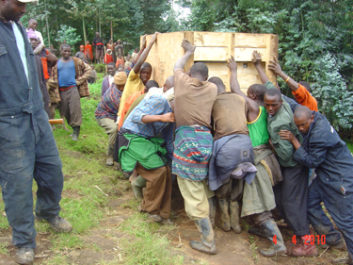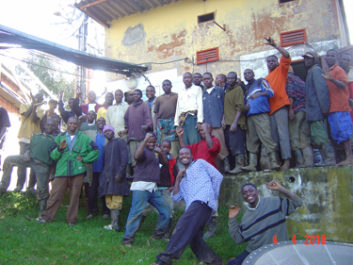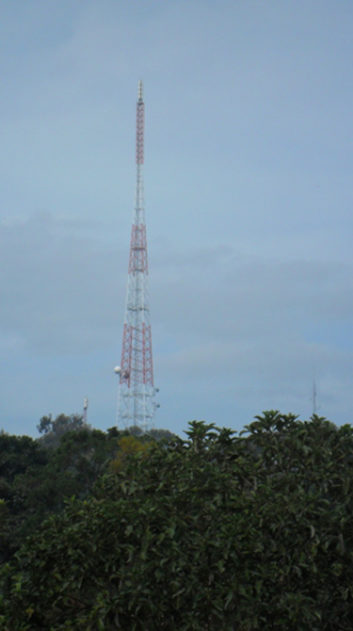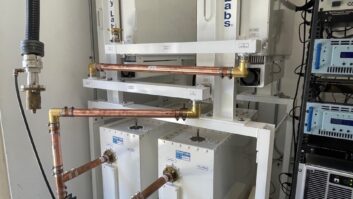KIGALI, Rwanda — In a land of a thousand hills, Mount Karisimbi is the tallest. Home to endangered mountain gorillas, the mountain is also a key link in the Rwanda Vision 2020 plan, which, among other goals, seeks to build a world-class telecommunications infrastructure for the country.
During 2010 a team of personnel from Harris Broadcast and Office Rwandais d’Information (ORINFOR), the state agency that oversees Radiyo Rwanda and TV Rwanda, managed a complete refit of the radio and television transmission infrastructure for Rwanda, a feat that helps achieve part of the Vision 2020 mandate and significantly improves the reach of radio and television signals across the country.

It also involved hauling a new transmitter and associated equipment up Mount Karisimbi — using only muscle power.
Across Rwanda, Harris Broadcast, working with its local partner, Techsys, examined, repaired, refitted and in some cases rebuilt 14 transmission sites across the country to support DVB-T digital television and FM radio operations.
“The scope of the project is to provide near 100 percent coverage for radio and television around the country,” said John Hall, director of radio and television programs for the Broadcast Communications Division of Harris Corp.
ENSURE COVERAGE
Harris began working with ORINFOR in 2008 when the company was contracted to supply three emergency FM transmitter kits for installation around the Rwandan capital city, Kigali.
That effort grew to the project to ensure coverage across the country of nearly 10 million people, a multi-million dollar project that was completed in mid December 2010.
“We had old systems, old towers,” said Innocent Nkurunziza, director of the technical department at ORINFOR.
“The rural areas were not covered, and people could not listen to Radiyo Rwanda or watch TVR.” And even in areas where the transmitters were still operational, their capabilities were limited. “The network infrastructure was not good, we had to refurbish old towers and build new towers to achieve our goal of increased coverage,” he said.
Most of the sites were first constructed in 1978, when Radiyo Rwanda launched FM broadcasting. Because of its small size and mountainous terrain, FM is a practical medium for radio broadcasting in the country. Over the years, and especially during the civil war, subsequent genocide and the regional wars that wracked Rwanda throughout the 1990s, many of the transmission sites were damaged and fell into disuse and disrepair.
NECESSARY TASKS
When Harris began assessing the sites to determine what was needed to rebuild the infrastructure, they developed a long list of necessary tasks.
“The electrical system wasn’t up to code and there were structural issues that needed to be addressed to keep the transmitters dry,” said Hall. Of the towers themselves, five needed to be completely replaced and the remaining nine needed reinforcing.

“Most of the towers were not able to support the weight of the microwave system being installed and the DVB-T spine,” said Nathan Smith, the Harris program manager overseeing the Rwanda project.
Each of the sites was also supplied with a generator to ensure backup power.
New circuit breakers and electrical panels were specified for each site, and switching systems were installed to manage the changeover between mains power and the generators.
“Power is not stable outside of Kigali,” said Hall. “At every site you will have periodic outages, thus the need for generators.”
Four of the transmission sites are running only on generator power until mains power lines can be run to connect them to the power grid.
Radiyo Rwanda operates one national FM service that broadcasts in Kinyarwanda, French and English, as well as five community radio stations.
The community stations are interconnected with the national station, transmitting from equipment co-located with the national network.
In all 31 solid-state FM transmitters were installed across the 14 sites, a mix of 1 kW Harris ZX 1000 FM units and 5 kW Harris Z5CDs.
“One of the requests was for broadband antennas to support frequency switching,” Smith said. This gives Radiyo Rwanda the flexibility to adjust its transmission frequencies to manage any interference or coverage issues that might arise.
Jampro Antennas/RF Systems President Alex Perchevitch said that the company worked with Harris to develop antenna configurations and then produced, delivered and installed the antennas.
Model JBVP broadband FM antennas with RCCC constant impedance combiners were selected for the project, although in a few cases the company refurbished and restored the existing FM antenna panels, originally installed in the 1970s.
The most challenging installation was atop the 4,507-meter-tall Mount Karisimbi. It was the most remote site in the project and one of two mountaintop sites inaccessible by vehicles, which means all of the necessary equipment and materials had to be hauled up the mountain by muscle power.
MOUNTAIN CLIMBING
“You have to go by foot, practically from the base of the mountain,” said Nkurunziza. “It takes about eleven hours to reach the summit, and you have to carry everything you want to take to the top, including winter clothes. The area is very cold when you reach the summit.”
Smith said it took several days to haul all the equipment up to the transmission site by hand. To ease future operation, and so that diesel fuel would not need to be carried all the way to the summit, the generator for the Mount Karisimbi site was installed in a crater at about 914 meters and power cabling was run up the mountain to the summit.
The tower atop the mountain peak raises the antennas another 40 meters into the sky.
“What was really challenging was that most of the work was done during the rainy season,” Perchevitch said.
The FM antenna on Mount Karisimbi was one of the ones slated for refurbishment instead of replacement, Perchevitch said, which meant carrying up what they hoped would be all the needed replacement parts.

The installation at Mount Mugogo also required equipment and supplies to be carried by hand to the site; however, it was a less arduous trek.
“It took me, not carrying anything but a backpack, about 20 minutes to get to the site. It took them six hours to carry all the equipment up,” Smith said of the Mugogo site.
The 14 sites are linked with Radiyo Rwanda and TVR headquarters in Kigali via microwave links supplied by Harris. As part of Vision 2020, Rwanda is installing fiber-optic cabling across the country to spread the reach of the Internet, and as fiber is pulled out to the transmitter sites they will be connected.
“We are going to bring the fiber up to our sites so that we can install a network management system and we can connect live from anywhere, using fiber to go back to the studio instead of having to pass through the satellite,” said Nkurunziza.
Even after fiber is pulled to each of the sites, the microwave systems will be kept in place, said Nkurunziza. “The fiber connections allow us to send a signal with greater quality, but the microwave links will be helpful if the fiber is cut or there are other problems; we can continue operating without interruption using the microwave system.”
FUTURE PLANS
The system has been designed to serve Rwanda’s needs for the next 30 years or beyond, and Harris has been contracted to help with upkeep and maintenance.
Spare parts and support will be provided by Techsys with additional support available from Harris offices in Europe or the United States, if necessary.
“We’ll come back semiannually to check the sites and recommend maintenance and repairs,” Hall said.
With transmission capabilities for the country now rebuilt, ORINFOR will turn its attention to upgrading production capabilities, particularly for television, to digital. “There is a tender process ongoing for radio and TV studios to be turned over to digital,” Nkurunziza said.
While television has begun transitioning to digital using the DVB-T standard, Nkurunziza said that there are no plans to move from FM analog radio to a digital radio system. Radiyo Rwanda trialed DRM30 on shortwave in 2006, but for now the costs of receivers are too high for most Rwandans and FM broadcasts are of sufficient quality. “We are monitoring developments, however,” said Nkurunziza, “and when it comes time to [reconsider digital radio] we will be ready.”
For now, Rwanda is happy to be a technology showcase for East Africa.
Already, Nkurunziza said, engineers from Kenya, Ethiopia, Uganda and Burundi have visited the country to see how Rwanda is remaking its broadcasting systems and information and communication technologies (ICT) infrastructure.












